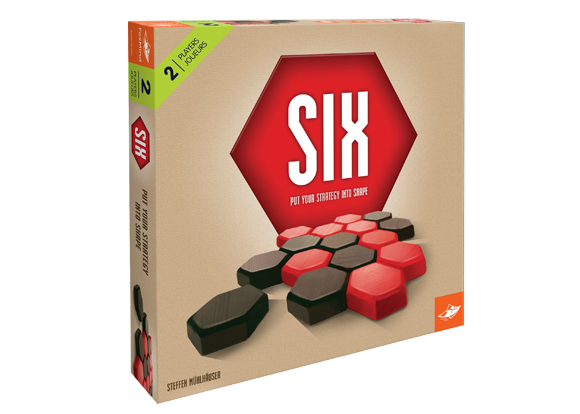SIX is a simple, yet engaging strategy game for players of all ages. SIX can be played with 2-4 players and typically only takes 10 minutes to complete. In SIX players take turns placing hexagon pieces, attempting to form one of the three winning shapes – a ring, a triangle, or a line – out of six tiles. If all tiles are placed without anyone winning, play continues with players moving their tiles that are in play. For players who want a challenge, there are modified rules to play a more advanced version of the game. During this game, players are developing their spatial sense, as well as gaining experience working with various symmetrical shapes.
Game Instructions:
The object of the game is to form one of the three winning shapes (a ring, a triangle, or a line) which all include six hexagons. Each player begins with all the hexagons of one colour. To begin one red hexagon and one black hexagon are placed side-to-side in the middle. Players take turns playing one hexagon. Black starts and on the first turn, they must place their piece edge-to-edge with the initial red hexagon (without touching the initial black hexagon). Afterward hexagons may be placed anywhere as long as they connect with a hexagon in play.
If all hexagons are placed without anyone winning, players move by taking turns to move a hexagon of their colour to a new location. The players may not move a hexagon if it splits the larger group into any number of smaller groups*. When a player forms a winning shape they must declare they have done so or they must wait until their next turn to do so.
 To play with four players, teammates sit opposite each other and the play continues counterclockwise. No communication is allowed between teammates (however, you can change this rule to encourage discussion).
To play with four players, teammates sit opposite each other and the play continues counterclockwise. No communication is allowed between teammates (however, you can change this rule to encourage discussion).
*In the advanced rules this rule changes. Players use isolation as a strategy to remove hexagons. If they split the hexagons into multiple groups, all of the hexagons in the smaller groups are removed. If the group is split into two equal-sized groups the player who is dividing them can choose which group to remove. If any player is left with less than six pieces in the group, the other player automatically wins, as they cannot create a winning shape.
If you are interested in viewing these rules in a PDF please click here.
Curriculum Connections
Coming soon.
Connections to Processes
Communication [C]: As students play SIX they will use mathematical language to discuss the position of their pieces, as well as the translations that are occurring and the shapes within the game. Students will be able to use the concrete materials to make connections with mental representations of mathematical ideas. If students play in pairs, you can modify the rules to allow and encourage them to communicate their strategies with their teammate.
Problem Solving [PS]: SIX is a can be played in a short time period, which allows students to experiment using multiple different strategies as they continue to play. Each game is different depending upon the strategies used and the location of the pieces, therefore students need to constantly adjust their strategy to account for the response of their opponent. A common strategy in SIX is to select one shape and attempt to conceal your plan until you place your winning piece.
Reasoning [R]: During SIX students will develop their reasoning skills as they constantly think multiple steps in advance in order to win. As the arrangements of the pieces are constantly changing, students must re-analyze each turn to ensure they make a good move. After students play they can discuss their reasoning behind their moves and how it led to their defeat or win.
Visualization [V]: SIX develops students visualization skills as they evolve from needing to physically translate their pieces, to be able to mentally represent various potential moves. Students also gain experience creating and working with various 2D (e.g. triangle winning shape) and 3D (e.g. hexagonal prisms) shapes. This experience prepares them to create nets of shapes and helps them to understand symmetry.

